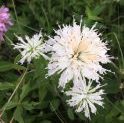July is the month of the Squash Takeover! (This is another 2018 post that’s been sitting in my “Drafts” folder.) In June, my squash plants seemed to be spaced out too thinly. I’d planted several bumpy green Hubbards (Curcubita maxima) from Linda Black Elk, as well as a couple Lakota squash.* But there was aContinue reading “July Squash Takeover”
Author Archives: Maštíŋčala Sáŋ
Waȟnáȟnaheča – Wild cucumber
Waȟnáȟnaheča — wild cucumbers! Some years, you can hardly find one in the woods or on the prairies, and other years, they seem to be growing everywhere. Their leaf shape and vining habit resemble domesticated cucumbers (kuŋkúŋ, or Cucumis sativus), which are native to India, but they are not closely related. Here are some waȟnáȟnahečaContinue reading “Waȟnáȟnaheča – Wild cucumber”
Thíŋpsiŋla Sú: Prairie Turnip Seed
When I was harvesting Thíŋpsiŋla / Thíŋpsiŋna / Prairie turnip / Pediomelum esculentum last year, this adorable little seed fell out in my hand: It fell out of the fuzzy flowerhead, and resembles a very small bean. When people dig thíŋpsiŋla, we pay special attention to what we do with the green, non-edible part ofContinue reading “Thíŋpsiŋla Sú: Prairie Turnip Seed”
Turning Weeds into Cough Medicine: Siberian Elm bark & root bark
These pictures have been sitting in my “Drafts” folder for a few years, and now seemed like an ideal time to turn them into a post. If you live in Western North Dakota, you know Siberian Elm trees (Ulmus pumila). Even if you don’t know the name, you probably know those annoying, papery, dime-sized seedsContinue reading “Turning Weeds into Cough Medicine: Siberian Elm bark & root bark”
Herbal Resilience Guide & PDF
We are happy to share this Herbal Guide to Collective Protection and Healing During COVID-19 with you. This was developed for the Sitting Bull College community earlier this week by community members, herbalists, and herbalism students. This is our gift to the community. Please feel free to share it. Linda Black Elk, one of theContinue reading “Herbal Resilience Guide & PDF”
Wínakapo — Hops
A common request I get, as someone who works with the plant medicines from the Dakotas, is for help managing sleeplessness or anxiety – but not with anything that will knock the patient out too long, leave them woozy, or be addictive. The flowers of this plant are my best solution. Wínakapo (Wild hops, HumulusContinue reading “Wínakapo — Hops”
Omníča Kačháŋ: Bean Winnowing
This is another waníyetu wičhóȟ’aŋ, or winter project. In a lot of ways, it’s pretty similar to corn winnowing (wagmíza kačháŋ). After harvesting the last of the dry beans for the season, I bring them inside to finish drying out. I usually put them in a basket. (You have to be careful where you placeContinue reading “Omníča Kačháŋ: Bean Winnowing”
Winter Projects: Wagmíza Yukpáŋ
This was one of my waníyetu wíčhoȟ’aŋ, or winter projects, last year. After the flour corn has hung in braids inside my home for a few months, dried out by time and the heaters that parch everyone and everything indoors during these Northern Great Plains winters, it’s ready to be made into cornmeal. First, aContinue reading “Winter Projects: Wagmíza Yukpáŋ”
Wáǧačhaŋ Wičháȟpi: Cottonwood Star
When I am introducing someone to the wáǧačhaŋ (cottonwood, or Populus deltoides) and its medicine for the first time, I love surprising them with the star. If you’re just using your hands to break the twigs you find on the ground, without a precise cutting tool, it might take a few attempts to find aContinue reading “Wáǧačhaŋ Wičháȟpi: Cottonwood Star”
Pápa (Bapa) Waháŋpi
This is one of my favorite traditional foods. Pápa (or Bapa, as it’s often called around here) is dried meat, usually wild game — and waháŋpi means “soup.” The main plant ingredients are sliced thíŋpsiŋla (Pediomelum esculentum) and waštúŋkala (dried sweet corn, Zea mays). This is a hearty, nourishing winter soup. I had this bowlContinue reading “Pápa (Bapa) Waháŋpi”
